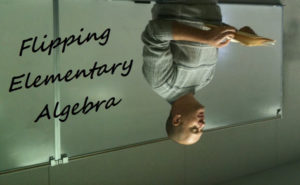Flipping Elementary Algebra
This semester I am teaching two sections of elementary algebra using a flipped classroom model. The approach is different than the way I have flipped my statistics course, but has been very effective. I am relying heavily on MyMathLab outside the classroom.
For each section that we cover …
- Students complete a “Flip” assignment before the material is discussed in class.
The assignment contains conceptual videos that introduce each topic as well as videos of examples where problems are worked out.
After students finish the videos, there are a handful of problems that they have to work through, and all of the learning aids (except “Show Example” are available. Students can try each problem as many times as they would like. - The “lecture” period is intended to involve active learning.
Some days begin with a class driven recap of what they learned in the Flip assignment. I count on students to drive this discussion, stepping in only when I have something to clarify or add. I mostly ask questions and wait for students to respond.
Most days involve group work or collaborative learning. Some days students turn in their assignments. Other days we go over answers as we go, or I ask students to share their answers and strategies at the board.
Every day is different, and I am looking for my students to be as agile in their learning as I am in my teaching. - After class, students take a 5 question “Reflect” quiz that focuses on the problems that I feel are most important.
The results on the student’s first Reflect quiz attempt load a personalized HW assignment, containing 3 exercises associated with each problem on the quiz. If a student gets a problem correct on the first quiz attempt, they get instant credit on the personalized HW for the 3 associated problems.
Students use the personalized HW for self remediation, then they can go back and take the quiz again as many times as they would like to.
One question many have about flipping the classroom is “What do you do if students arrive unprepared?” In my experience, having the Flip assignments due for a grade motivates students to do them. Also, because they hear their classmates participating in the discussions and contributing during “lecture they feel more compelled to be prepared themselves. I have seen some of my students in the tutorial center in the morning before class starts trying to get some help to make sure they understand the material, and that can only lead to good things.
I am happy with the way things are going, and I am progressing towards less discussion at the beginning of class as my students become stronger. It gives me (& my embedded tutor) more opportunities to walk around during class and talk to students one-on-one, clarifying as we go.
The classes just took the exam on Chapter 3 (Graphing lines, equations of lines), and 61 out of 71 students passed the exam. The mean score in each class was in the high 80s, with median scores of 92 and 93 in the two classes. This test was very similar to the test I gave last semester, but the results are much stronger. On to systems of equations …
Are you flipping your classroom? I’d love to hear what you are doing. Interested in trying this approach? Please leave a comment on this blog, contact me through the contact page on my website, or reach out to me on Twitter (@georgewoodbury).
I am a mathematics instructor at College of the Sequoias in Visalia, CA, as well as the author of algebra and statistics textbooks with Pearson.
